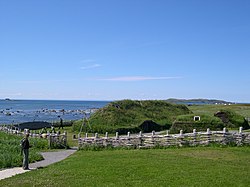L'Anse aux Meadows
| L'Anse aux Meadows National Historic Site | |
|---|---|
|
UNESCO world heritage |
|

|
|
| Reconstruction of the Viking settlement |
|
| National territory: |
|
| Type: | Culture |
| Criteria : | (vi) |
| Surface: | 7,991 ha |
| Reference No .: | 4bis |
| UNESCO region : | Europe and North America |
| History of enrollment | |
| Enrollment: | 1978 ( session 2 ) |
| Extension: | 2017 |
L'Anse aux Meadows is a former Icelandic - Greenlandic settlement on Newfoundland , which is mainly attributed undifferentiated to Vikings in Anglo-Saxon literature . It is located at the northernmost end of the island and only existed for a few years around 1000.
The place name is a French-English mixed form, as it often occurs in eastern Canada and means something like "The bay near the meadows" ( French anse 'bay' , English meadow 'meadow' ). The name could also be a deformation of the French L'Anse-aux-Méduses (“Jellyfish Bay”).
history
The settlement was created around 1000, possibly by Leif Eriksson's expedition. It could therefore have been Markland or Vinland . More recent research suggests that Markland is likely to be located in the area of Labrador , while the name Vinland could apply to Newfoundland because of the occurrence of wild grapes at that time. After a significant climate change in the 12th and 13th centuries, wine no longer grew on Newfoundland, which is why Vinland was mistakenly searched for a long time further south.
The Scandinavian settlement was probably only inhabited for a few years. On one hand the point sagas that of fighting as Skraelings designated natives (whether Indian or Inuit comes from the texts not clear) report, on the other hand, the archaeological findings. Only a few slag were found in the forge , a maximum of a few kilograms of iron were forged. The fact that hardly any valuables or weapons were found during the excavations speaks for an orderly withdrawal of the settlers and abandoning the small town.
From a European perspective, the settlement, which is the only one of its kind discovered in North America to date, is of paramount importance - it proves the long-debated theory that the discovery of America by European navigators took place 500 years before Christopher Columbus . However, in contrast to the journeys of Columbus, the Scandinavian expeditions remained largely without consequences in terms of world history.
In the area around L'Anse aux Meadows lived at least since 4000 BC. Chr. People. A distinction is made between five to six different groups, including members of the Inuit culture , who are often still referred to as Dorset Eskimos. They lived at least in the 8th century AD at the southern end of the bay, but there is no evidence that they also lived there around 1000 AD.
Excavations
The settlement on Epaves Bay was excavated from 1961 by the Norwegians Helge and Anne-Stine Ingstad . It consisted of eleven houses as well as a forge that used lawn iron that the Indians did not know. It is the only proven Scandinavian settlement in North America . The architectural style of the houses corresponded to that of the contemporary Icelanders and Greenlanders, the sod house . Few artifacts were found in the houses , including a bronze needle and a spindle whorl . A bone needle was possibly a kind of knitting needle. A whetstone for sharpening scissors and blades was also discovered.
Parks Canada continued the excavation from 1973 to 1976 . The focus was on the peat bog below the settlement terrace. Around 2000 wooden artifacts were discovered there in three shifts. In one of the shifts that could be assigned to the Scandinavians, there was processing waste, probably from shipbuilding, plus a floor plank. In order not to destroy the archaeological traces and to keep them open for future research, the site was again covered with sand and peat.
It was declared a World Heritage Site by UNESCO in 1978 . The prerequisite was the preservation of the archaeological site and its pieces in situ , i.e. at the site itself. Two houses were reconstructed and are now a tourist attraction. A Visitor Information Center provides an introduction to the history of the site. Before the settlement was declared a World Heritage Site, it was declared a National Historic Site of Canada on November 28, 1968 .
See also
literature
- Helge Ingstad , Anne-Stine Ingstad : The Viking Discovery of America: The Excavation of a Norse Settlement in L'Anse Aux Meadows . Newfoundland 2001.
- Paul M. Ledger, Linus Girdland-Flink and Véronique Forbes: New horizons at L'Anse aux Meadows. In: PNAS . Online pre-publication of July 15, 2019, doi: 10.1073 / pnas.1907986116
- Farley Mowat: The Farfarers - before the Norse . Toronto 1998.
- Birgitta Wallace: L'Anse Aux Meadows, Leif Eriksson's Home in Vinland. In: Journal of the North Atlantic. 2 (sp2), 2009, pp. 114–125, full text
Web links
- Entry on the UNESCO World Heritage Center website ( English and French ).
- DL Ashliman: Vikings in America ( Memento from November 1, 2012 in the Internet Archive ) (English)
- L'Anse aux Meadows National Historic Site of Canada, Parks Canada
Remarks
- ↑ Discover. In: L'Anse aux Meadows National Historic Site. Parks Canada , March 30, 2017, accessed August 5, 2020 (English): "A small whetstone, used to sharpen needles and small scissors, was found near the spindle whorl."
- ^ L'Anse aux Meadows National Historic Site of Canada. In: Canada's Historic Places. Parks Canada, January 17, 2006, accessed August 5, 2020 : "Formally Recognized: 1968/11/28"
Coordinates: 51 ° 35 ′ 42 " N , 55 ° 31 ′ 49" W.



